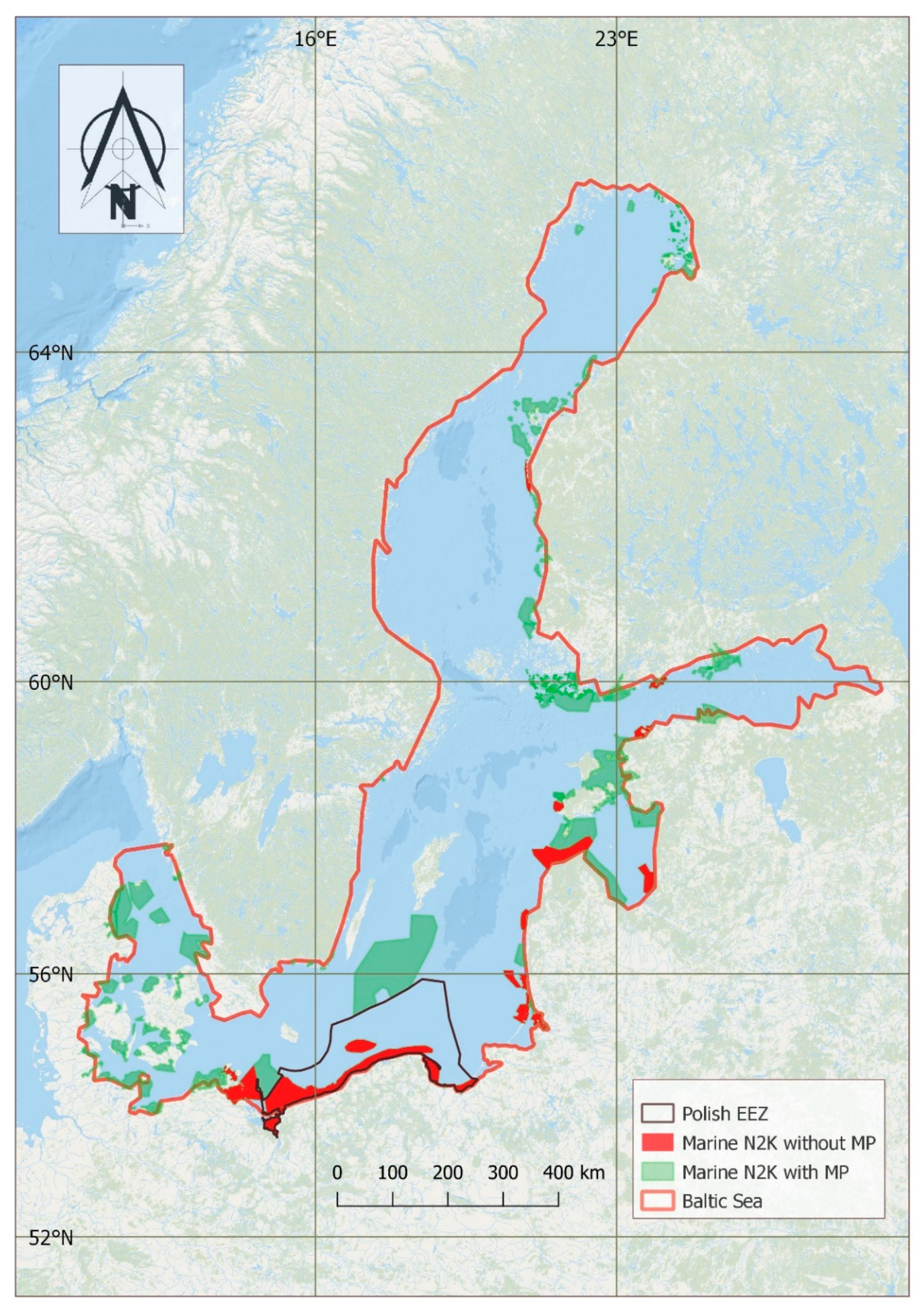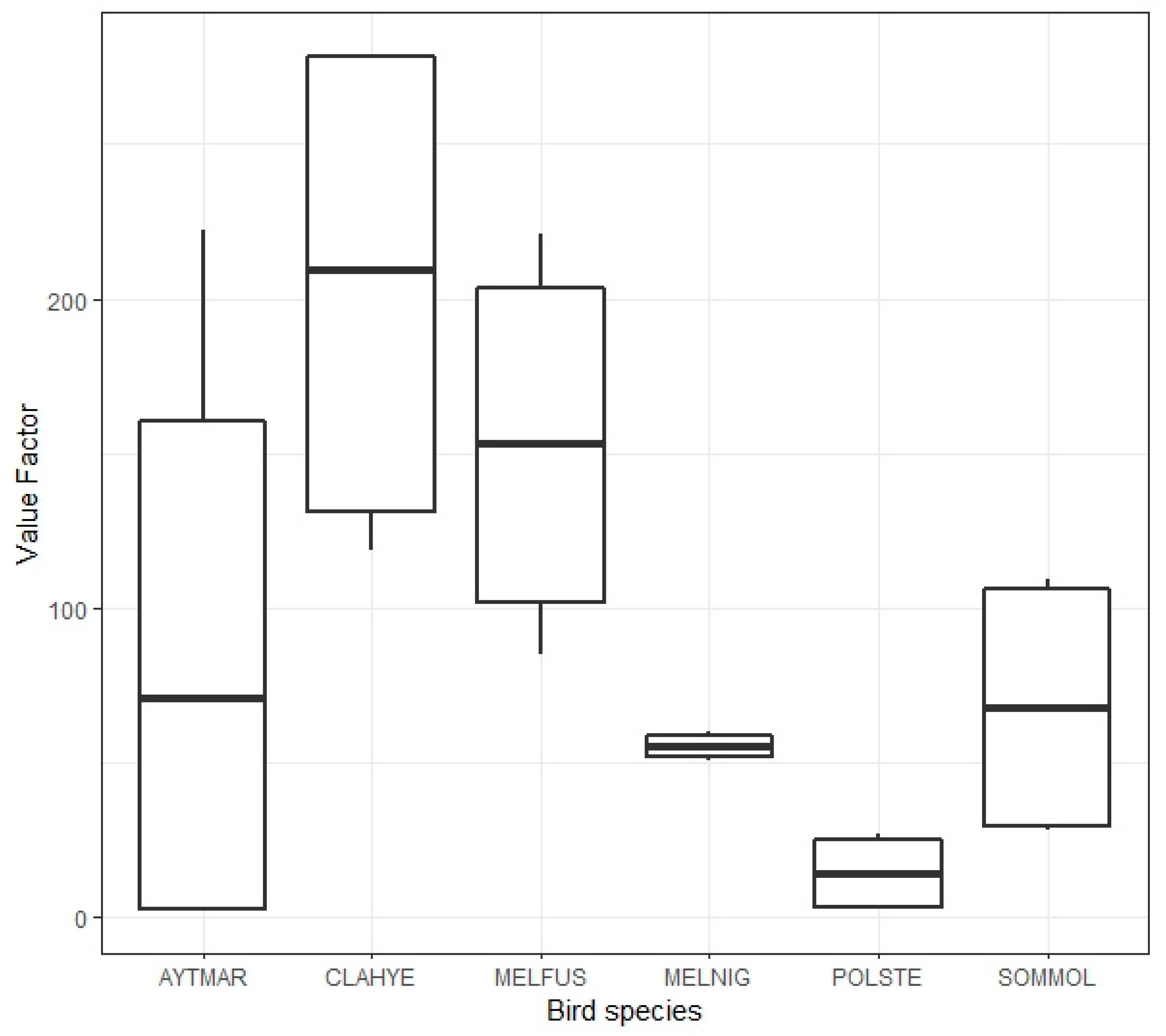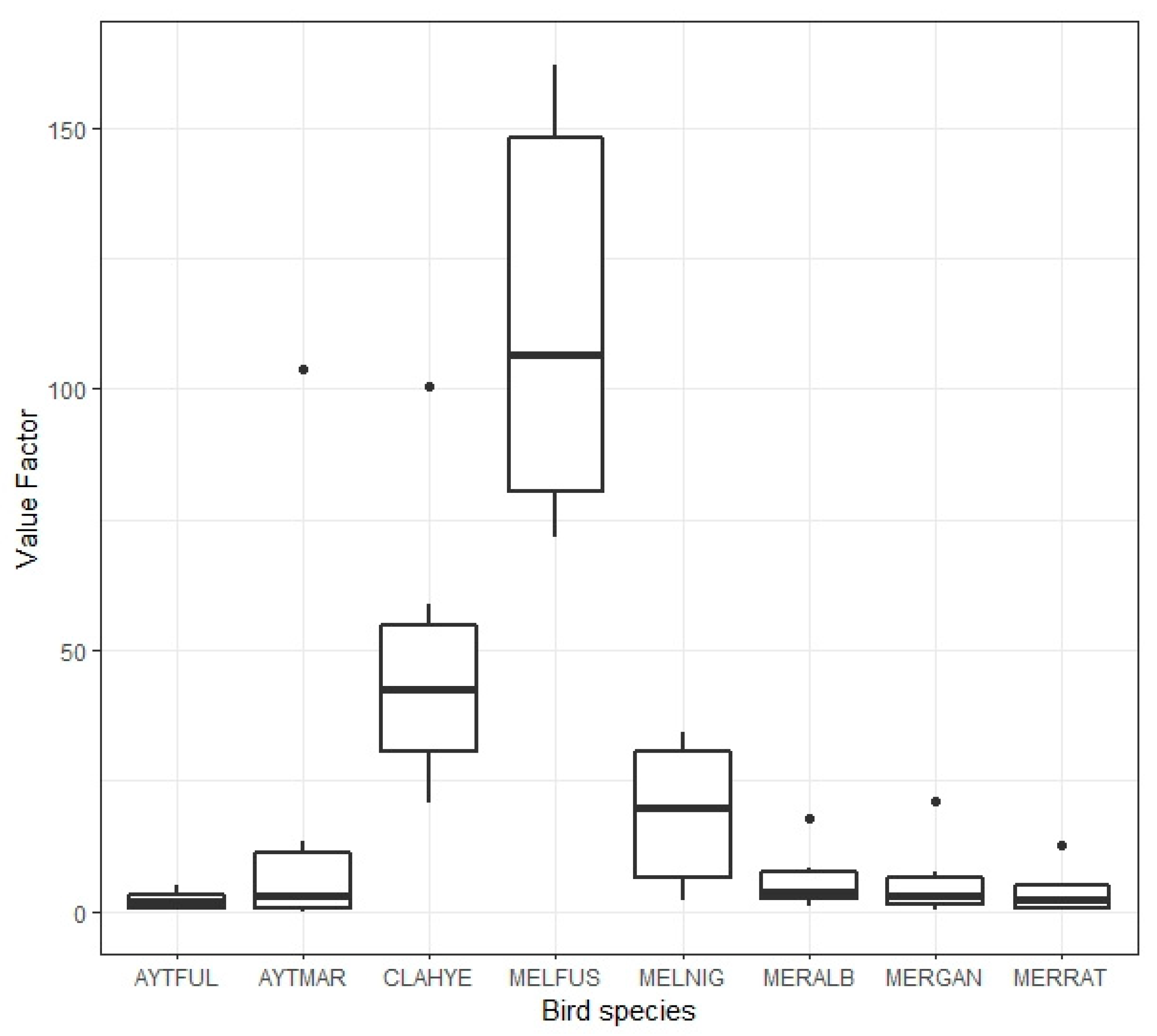Management of Marine Natura 2000 Sites as Exemplified by Seabirds Wintering in the Baltic Sea: The Case of Poland
Abstract
1. Introduction
2. Materials and Methods
2.1. Number of Wintering Waterbirds on the Baltic Sea
2.2. Assessing the Value of the Baltic Sea
2.3. Effectiveness of Natura 2000 Sites for Protecting the Species with the Highest VF
2.4. The Exclusive Economic Zone with the Fewest Number of Management Plans Implemented
3. Results
3.1. Wintering Waterbirds on the Baltic Sea
3.2. Wintering Waterbirds on the Polish Part of the Baltic Sea
4. Discussion
5. Conclusions
Author Contributions
Funding
Institutional Review Board Statement
Data Availability Statement
Acknowledgments
Conflicts of Interest
References
- Soule, M.E. Conservation: Tactics for a Constant Crisis. Science 1991, 253, 744–750. [Google Scholar] [CrossRef] [PubMed]
- Hooper, D.; Adair, E.; Cardinale, B.; Byrnes, J.E.K.; Hungate, B.A.; Matulich, K.L.; Gonzalez, A.; Duffy, J.E.; Gamfeldt, L.; O’Connor, M.I. A global synthesis reveals biodiversity loss as a major driver of ecosystem change. Nature 2012, 486, 105–108. [Google Scholar] [CrossRef] [PubMed]
- Díaz, S.; Fargione, J.; Chapin, F.S., III; Tilman, D. Biodiversity Loss Threatens Human Well-Being. PLoS Biol. 2006, 4, e277. [Google Scholar] [CrossRef] [PubMed]
- Gantioler, S.; Rayment, M.; ten Brink, P.; McConville Kettunen, M.A.; Bassi, S. The costs and socio-economic benefits associated with the Natura 2000 network. Int. J. Sustain. Soc. 2014, 6, 135–157. [Google Scholar] [CrossRef]
- Jantke, K.; Schleupner, C.; Schneider, U.A. Gap analysis of European wetland species: Priority regions for expanding the Natura 2000 network. Biodivers. Conserv. 2011, 20, 581–605. [Google Scholar] [CrossRef]
- Sundseth, K.; Creed, P. Natura2000, Protecting Europe’s Biodiversity; Office for Official Publications of the European Communities: Luxembourg, 2008; pp. 1–296. [Google Scholar]
- Pellissier, V.; Schmucki, R.; Pe’er, G.; Aunins, A.; Brereton, T.M.; Brotons, L.; Carnicer, J.; Chodkiewicz, T.; Chylarecki, P.; del Moral, J.C.; et al. Effects of Natura 2000 on nontarget bird and butterfly species based on citizen science data. Conserv. Biol. 2019, 34, 666–676. [Google Scholar] [CrossRef]
- Ostermann, O.P. The need for management of nature conservation sites designated under Natura 2000. J. Appl. Ecol. 1998, 35, 968–973. [Google Scholar] [CrossRef]
- Sharp, R. Responding to Europeanisation. In British Environmental Policy and Europe: Politics and Policy in Transition; Lowe, P., Ward, S., Eds.; Routledge: London, UK, 1998; pp. 33–56. [Google Scholar]
- Evans, D. Building the European Union’s Natura 2000 network. Nat. Conserv. 2012, 1, 11–26. [Google Scholar] [CrossRef]
- European Commision. Communication from the Commission to the European Parliament, the European Council, the Council, the European Economic and Social Committee and the Committee of the Regions. EU Biodiversity Strategy for 2030 Bringing Nature Back into Our Lives. COM 380; European Commission: Brussels, Belgium, 2020. [Google Scholar]
- European Commision. Communication from the Commission to the European Parliament, the European Council, the Council, the European Economic and Social Committee and the Committee of the Regions. The European Green Deal. COM 640; European Commission: Brussels, Belgium, 2019. [Google Scholar]
- European Commision. Criteria and Guidance for Protected Areas Designations; European Commission: Brussels, Belgium, 2022. [Google Scholar]
- Amat, J.A.; Green, A.J. Waterbirds as Bioindicators of Environmental Conditions. In Conservation Monitoring in Freshwater Habitats: A Practical Guide and Case Studies; Hurford, C., Schneider, M., Cowx, I., Eds.; Springer: London, UK, 2010. [Google Scholar] [CrossRef]
- Gregory, R.D.; van Strien, A. Wild bird indicators: Using composite population trends of birds as measures of environmental health. Ornithol. Sci. 2010, 9, 3–22. [Google Scholar] [CrossRef]
- Amano, T.; Székely, T.; Sandel, B.; Nagy, S.; Mundkur, T.; Langendoen, T.; Blanco, D.; Soykan, C.U.; Sutherland, W.J. Successful conservation of global waterbird populations depends on effective governance. Nature 2017, 553, 199–202. [Google Scholar] [CrossRef]
- Durinck, J.; Skov, H.; Jensen, E.P.; Pihl, S. Important Marine Areas for Wintering Birds in the Baltic Sea. Colonial Waterbirds 1996, 19, 157. [Google Scholar] [CrossRef]
- Skov, H.; Heinanen, S.; Žydelis, R.; Bellebaum, J.; Bzoma, S.; Dagys, M.; Durinck, J.; Garthe, S.; Grishanov, G.; Hario, M.; et al. Waterbird Populations and Pressures in the Baltic Sea; Nordic Council of Ministers: Copenhagen, Denmark, 2011. [Google Scholar]
- Mendel, B.; Sonntag, N.; Wahl, J.; Schwemmer, P.; Dries, H.; Guse, N.; Müller, S.; Garthe, S. Profiles of Seabirds and Waterbirds of the German North and Baltic Seas: Distribution, Ecology and Sensitivities to Human Activities within the Marine Environment; BFN: Bonn–Bad Godesberg, Germany, 2008; ISBN 9783784339610. [Google Scholar]
- Del Hoyo, J.; Collar, N.J. HBW and BirdLife International Illustrated Checklist of the Birds of the World: Non-Passerines; Lynx Edicions: Barcelona, Spain, 2014; Volume 1. [Google Scholar]
- Wetlands International. Waterbird Population Estimates. Available online: https://wpe.wetlands.org (accessed on 13 May 2020).
- Marchowski, D.; Leitner, M. Conservation implications of extraordinary Greater Scaup (Aythya marila) concentrations in the Odra Estuary, Poland. Condor 2019, 121, duz013. [Google Scholar] [CrossRef]
- Fox, A.D.; Petersen, I.K. Offshore wind farms and their effects on birds. Dansk Orn. Foren. Tidsskr. 2019, 113, 86–101. [Google Scholar]
- Dias, M.P.; Martin, R.; Pearmain, E.J.; Burfield, I.J.; Small, C.; Phillips, R.A.; Yates, O.; Lascelles, B.; Borboroglu, P.G.; Croxall, J.P. Threats to seabirds: A global assessment. Biol. Conserv. 2019, 237, 525–537. [Google Scholar] [CrossRef]
- Žydelis, R.; Bellebaum, J.; Österblom, H.; Vetemaa, M.; Schirmeister, B.; Stipniece, A.; Dagys, M.; Eerden, M.; Garthe, S. Bycatch in gillnet fisheries—An overlooked threat to waterbird populations. Biol. Conserv. 2009, 142, 1269–1281. [Google Scholar]
- Marchowski, D. Bycatch of seabirds in the Polish part of the southern Baltic Sea in 1970–2018: A review. Acta Ornithol. 2021, 56, 139–158. [Google Scholar] [CrossRef]
- IUCN. The IUCN Red List of Threatened Species. Version 2020-1. 2020. Available online: https://www.iucnredlist.org (accessed on 20 September 2020).
- Marchowski, D.; Ławicki, Ł.; Fox, A.D.; Nielsen, R.D.; Petersen, I.K.; Hornman, M.; Nilsson, L.; Haas, F.; Wahl, J.; Kieckbusch, J.; et al. Effectiveness of the European Natura 2000 network to sustain a specialist wintering waterbird population in the face of climate change. Sci. Rep. 2020, 10, 1–12. [Google Scholar] [CrossRef]
- Wilhere, G.F. Adaptive Management in Habitat Conservation Plans. Conserv. Biol. 2002, 16, 20–29. [Google Scholar] [CrossRef]
- Hearn, R.D.; Harrison, A.L.; Cranswick, P.A. International Single Species Action Plan for the Conservation of the Long-Tailed Duck (Clangula hyemalis); Technical Series No. 57; AEWA: Bonn, Germany, 2015. [Google Scholar]
- Dagys, M.; Hearn, R. International Single Species Action Plan for the Conservation of the Velvet Scoter (Melanitta fusca) W Siberia & N Europe/NW Europe Population; Technical Series No. 67; AEWA: Bonn, Germany, 2018. [Google Scholar]
- Chodkiewicz, T.; Chylarecki, P.; Sikora, A.; Wardecki, Ł.; Bobrek, R.; Neubauer, G.; Marchowski, D.; Dmoch, A.; Kuczyński, L. The report under Article 12 of the Birds Directive in Poland for the period 2013–2018: Status, trends, threats. Biul. Monit. Przyr. 2019, 20, 1–80, (In Polish with English Summary). [Google Scholar]
- Ławicki, Ł.; Guentzel, S.; Wysocki, D. Projects of the Conservation Plans for SPAs Natura2000, the Szczecin Lagoon PLB320009, the Kamień Lagoon and Dziwna PLB320011 and the Odra Mouth River and Szczecin Lagoon PLH320018, Szczecin, Poland. Report for the Maritime Office in Szczecin; Project No. POIS.05.03.00-00-280/10. ECO-EXPERT Sp.j.; Maritime Institute: Gdańsk, Poland, 2012. (In Polish) [Google Scholar]
- Meissner, W.; Bzoma, S. Awifauna. In Summary Report on the Analysis of Available Data and Conducted Natural Inventories (Collection and Analysis of Inventory Results, Unpublished Materials and Published Studies, Useful for Preparing Draft of Management Plan) Puck Bay (PLB 220005); Kruk-Dowgiałło, L., Ed.; Maritime Institute: Gdańsk, Poland, 2014. (In Polish) [Google Scholar]
- Meissner, W.; Bzoma, S. Awifauna. In Summary Report on the Analysis of Available Data and Conducted Natural Inventories (Collection and Analysis of Inventory Results, Unpublished Materials and Published Studies, Useful for Preparing Draft of Management Plan) Wisła Mouth (PLB220004); Kruk-Dowgiałło, L., Ed.; Maritime Institute: Gdańsk, Poland, 2014. (In Polish) [Google Scholar]
- Skov, H.; Durink, J.; Leopold, M.F.; Tasker, M.L. A quantitive method for evaluating the importance of marine areas for conservation of birds. Biol. Conserv. 2007, 136, 362–371. [Google Scholar] [CrossRef]
- Heath, M.F.; Evans, M.I.; Hoccum, D.I.; Payne, A.J.; Peet, N.B. Important Bird Areas in Europe: Priority Sites for Conservation; BirdLife Conservation Series No. 8; BirdLife International: Cambridge, UK, 2001; Volume 2. [Google Scholar]
- IUCN. The IUCN Red List of Threatened Species. Version 2022-1. 2022. Available online: https://www.iucnredlist.org (accessed on 24 September 2022).
- BirdLife International. Important Bird Area (IBA) GIS data request. Data Zone. 2022. Available online: datazone.birdlife.org (accessed on 24 September 2022).
- Marchowski, D.; Ławicki, Ł.; Kaliciuk, J.; Guentzel, S.; Kajzer, Z. Long-term changes in the numbers of waterbirds at an important European wintering site. Acta Biol. 2018, 5, 111–122. [Google Scholar] [CrossRef]
- Bellebaum, J.; Schirmeister, B.; Sonntag, N.; Garthe, S. Decreasing but still high: Bycatch of seabirds in gillnet fisheries along the German Baltic coast. Aquat. Conserv. Mar. Freshw. Ecosyst. 2013, 23, 210–221. [Google Scholar] [CrossRef]
- Stempniewicz, L. Marine birds drowning in the fishing nets in the Gulf of Gdańsk (southern Baltic): Numbers, species composition, age and sex structure. Ornis Svec. 1994, 4, 123–132. [Google Scholar]
- Marchowski, D.; Jankowiak, Ł.; Ławicki, Ł.; Wysocki, D.; Chylarecki, P. Fishery bycatch is among the most important threats to the European population of Greater Scaup Aythya marila. Bird Conserv Int. 2020, 30, 176–193. [Google Scholar] [CrossRef]
- Žydelis, R.; Small, C.; French, G. The incidental catch of seabirds in gillnet fisheries: A global review. Biol. Conserv. 2013, 162, 76–88. [Google Scholar] [CrossRef]
- EU Council. Council Agreement on 2020 Catch Limits in the Baltic Sea; Council of the European Union. Luxembourg. 2019. Available online: https://www.consilium.europa.eu/media/41053/191014-15-baltic-tacs_table.pdf (accessed on 25 September 2022).
- Marchowski, D.; Jankowiak, Ł.; Wysocki, D.; Ławicki, Ł.; Girjatowicz, J. Ducks change wintering pattern due to changing climate in the important wintering waters of the Odra River Estuary. PeerJ 2017, 5, e3604. [Google Scholar] [CrossRef]
- Lehikoinen, A.; Jaatinen, K.; Vahatalo, A.V.; Preben, C.; Crowe, O.; Deceuninck, B.; Hearn, R.; Holt, C.A.; Hornman, M.; Keller, V.; et al. Rapid climate driven shifts in wintering distributions of three common waterbird species. Glob. Change Biol. 2013, 19, 2071–2081. [Google Scholar] [CrossRef]
- Pavon-Jordan, D.; Fox, A.D.; Clausen, P.; Dagys, M.; Deceuninck, B.; Devos, K.; Hearn, R.D.; Holt, C.A.; Hornman, M.; Keller, V.; et al. Climate-driven changes in winter abundance of a migratory waterbird in relation to EU protected areas. Divers. Distrib. 2015, 21, 571–582. [Google Scholar] [CrossRef]
- Pulliam, H.R. Sources, sinks, and population regulation. Am. Nat. 1988, 132, 652–661. [Google Scholar] [CrossRef]



| Species | Global Population | % in Polish EEZ | Flyway Population | % in Polish EEZ | IUCN Global threat Status | European Red List and Local Trend |
|---|---|---|---|---|---|---|
| Velvet Scoter | 451,500 [21] | 54 [32] | 450,000 [21] | 54 [32] | VU ↓ [38] | VU↓ [39] |
| Common Scoter | 687,000–815,000 [21] | 34–41 [33] | 687,000–815,000 [21] | 34–41 [33] | LC ? [38] | LC ? [39] |
| Long-tailed Duck | 3,200,000–3,750,000 [21] | 14–17 [32] | 1,600,000 [21] | 33 [32] | VU ↓ [38] | LC ↓ [39] |
| Greater Scaup | 4,760,000–5,095,000 [21] | 2 [40] | 150,000–275,000 [21] | 35–63 [40] | LC ↓ [38] | LC ↓ [39] |
| Red-breasted Merganser | 368,000–521,000 [21] | 1–2 [32] | 70,000–105,000 [21] | 6–10 [32] | LC → [38] | NT ↓ [39] |
| Goosander | 1,571,500–2,436,000 [21] | 2 [32] | 177,000–277,000 [21] | 13–21 [32] | LC ? [38] | LC → [39] |
| Smew | 99,000–123,000 [21] | 3–4 [32] | 24,000–38,000 [21] | 11–18 [32] | LC ↓ [38] | LC → [39] |
| Tufted Duck | 2,000,000–2,600,000 [21] | 2 [32] | 800,000–1,000,000 [21] | 5–6 [32] | LC → [38] | NT ↓ [39] |
| Site Code | Basis | Area km² | Date SPA/SCI Class | MP y/n | Managing Authority | No. of Project | Funds EURO | Duration |
|---|---|---|---|---|---|---|---|---|
| PLB220005 | BD | 625.2 | 2004 | no | MOG | POIS.05.03.00-00-281/10 | 700,889 | 2011–2014 |
| PLB280010 | BD | 322.7 | 2004 | no | MOG | POIS.05.03.00-00-281/10 | ||
| PLB220004 | BD | 17.5 | 2004 | no | MOG | POIS.05.03.00-00-281/10 | ||
| PLH220032 | HB | 266.0 | 2004 | no | MOG | POIS.05.03.00-00-281/10 | ||
| PLH220044 | HB | 8.8 | 2007 | no | MOG | POIS.05.03.00-00-281/10 | ||
| PLH280007 | HB | 409.2 | 2004 | no | MOG | POIS.05.03.00-00-281/10 | ||
| PLB990002 | BD | 1948.4 | 2004 | no | MOS | 0 | ||
| PLC990001 | BD/HB | 801.2 | 2004 | no | MOS | POIS.02.04.00-00-0027/17-00 | 891,691 | 2018–2020 |
| PLB320009 | BD | 471.6 | 2004 | no | MOSZ | POIS.05.03.00-00-280/10 | 422,626 | 2011–2014 |
| PLB320011 | BD | 125.0 | 2007 | no | MOSZ | POIS.05.03.00-00-280/10 | ||
| PLB990003 | BD | 3090.7 | 2004 | no | MOSZ | POIS.05.03.00-00-280/10 | ||
| PLH320018 | HB | 525.7 | 2006 | no | MOSZ | POIS.05.03.00-00-280/10 | ||
| PLH990002 | HB | 2429.5 | 2004 | no | MOSZ | POIS.05.03.00-00-280/10 |
| IBA Code | SPA Code | SPA km² | IBA km² | SPA Qualif. sp. | IBA Qualif. sp. |
|---|---|---|---|---|---|
| PL002 | PLB320009 | 472 | 563 | TD, GS, S, G | TD, GS, S, G |
| PL011 | PLB320011 | 125 | 125 | S, G | S |
| PLM3 | PLB990003 | 3091 | 3119 | CS, VS, LTD, RBM | CS, VS, RBM, |
| PL024 | PLB220005 | 625 | 624 | TD, GS, VS, CS, S, G, RBM | TD, GS, S, G |
| PL029 | PLB280010 | 323 | 304 | TD, S | S |
| PLM2 | PLB990002 | 1948 | 1946 | VS, CS, LTD | LTD, VS |
| PLM1 | PLC990001 | 801 | 801 | LTD | LTD |
| PL027 | PLB220004 | 18 | 24 | TD, GS, LTD, S, G | G |
| PLM4 | - | 0 | 166 | - | VS |
| SE067 | - | 0 | 229 | - | LTD |
Publisher’s Note: MDPI stays neutral with regard to jurisdictional claims in published maps and institutional affiliations. |
© 2022 by the authors. Licensee MDPI, Basel, Switzerland. This article is an open access article distributed under the terms and conditions of the Creative Commons Attribution (CC BY) license (https://creativecommons.org/licenses/by/4.0/).
Share and Cite
Marchowski, D.; Ławicki, Ł.; Kaliciuk, J. Management of Marine Natura 2000 Sites as Exemplified by Seabirds Wintering in the Baltic Sea: The Case of Poland. Diversity 2022, 14, 1081. https://doi.org/10.3390/d14121081
Marchowski D, Ławicki Ł, Kaliciuk J. Management of Marine Natura 2000 Sites as Exemplified by Seabirds Wintering in the Baltic Sea: The Case of Poland. Diversity. 2022; 14(12):1081. https://doi.org/10.3390/d14121081
Chicago/Turabian StyleMarchowski, Dominik, Łukasz Ławicki, and Jacek Kaliciuk. 2022. "Management of Marine Natura 2000 Sites as Exemplified by Seabirds Wintering in the Baltic Sea: The Case of Poland" Diversity 14, no. 12: 1081. https://doi.org/10.3390/d14121081
APA StyleMarchowski, D., Ławicki, Ł., & Kaliciuk, J. (2022). Management of Marine Natura 2000 Sites as Exemplified by Seabirds Wintering in the Baltic Sea: The Case of Poland. Diversity, 14(12), 1081. https://doi.org/10.3390/d14121081









